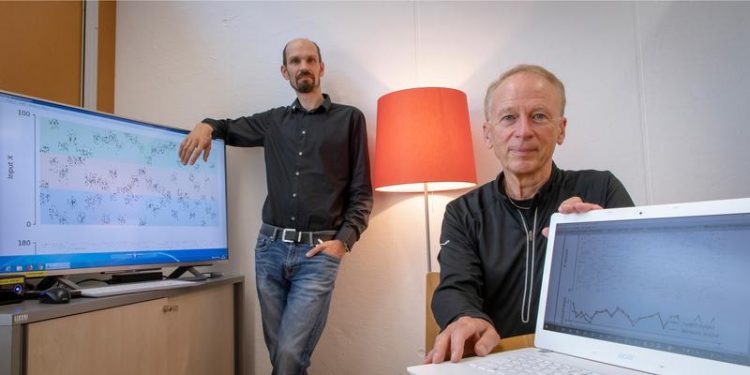New approach for a biological programming language

TU Graz computer scientists Robert Legenstein and Wolfgang Maass are working with other researchers to take AI a big step further. Jimmy Lunghammer / lunghammer.at © Lunghammer - TU Graz
Specifically, the researchers have succeeded in mathematically modelling the emergence and interaction between so-called “assemblies”.
These are neuron groups in the brain that form the basis for higher cognitive abilities such as thinking, imagining, arguing, planning or speech processing.
Better understanding of how the brain works
The Canadian neuroscientist Donald H. Hebb postulated as early as 1949 that neurons form such groups, in other words that they act together to encode individual words or symbols, as well as holistic “concepts”.
“However, the existence of assemblies has only become more consolidated in recent years, and our models are based on the latest results from brain research,” explains Maass.
Assemblies are flowing entities that constantly reorganize themselves to process environmental stimuli, give them a symbolic meaning, structure them and transform them into knowledge.
This adaptability – also called plasticity – provides the brain with the ability to get over its limited processing capacity and form an “unlimited” number of patterns.
The results not only contribute to a better understanding of the brain, they could also lead to efficient new AI methods as they combine the advantages of two main approaches to AI research: the symbolic and the connectionist.
Symbolic vs. connectionist information processing
Algorithms in symbol systems are based on defined rules (if/then commands) and logical formulas, and are persuasive through their ability to abstract: i.e. the ability to generalize and to apply general contexts to concrete facts. For this reason they are optimally suited for easy application to completely new situations.
However, symbol-based systems must be programmed in a complex way and cannot be trained for demanding applications by means of large amounts of data, as is possible with neural networks.
The latter consist of small, networked and adaptive computing units that are self-organizing and can quickly solve complex problems when working together.
The learning ability of neural networks has made the connectionist approach more attractive for current AI research and for modern AI applications. However, neural networks have difficulties with tasks that did not occur in their training set.
“Human” brain architecture for machines
The assembly models presented now aim to combine the ability to abstract with the ability to learn. “These are neural networks that work symbolically with their assemblies. The paradigm we use is the human brain, which also combines both,” said Legenstein.
The work, which also involves researchers from the University of Nottingham, the University of California, Berkeley, and the Georgia Institute of Technology, is being partially incorporated into the Human Brain Project (HBP) – a Europe-wide interdisciplinary research association that has been working since 2015 on electronically reconstructing the human brain and simulating its functions. Wolfgang Maass and his team are responsible for the Principles of Brain Computation work package (https://www.humanbrainproject.eu/en/silicon-brains/how-we-work/computational-pri…) in the Human Brain Project.
This research work is funded by the Austrian Science Fund (FWF) and the Human Brain Project (https://www.humanbrainproject.eu/en/). It is anchored in the Fields of Expertise “Human and biotechnology” (https://www.tugraz.at/en/research/forschungsschwerpunkte-5-fields-of-expertise/h…) and “Information, Communication & Computing” (https://www.tugraz.at/en/research/fields-of-expertise/information-communication-…), two of the five Fields of Expertise of TU Graz.
TU Graz | Institute of Theoretical Computer Science
Wolfgang MAASS
Em.Univ.-Prof. Dipl.-Ing. Dr.rer.nat.
Phone: +43 316 873 5822
maass@igi.tugraz.at
Robert LEGENSTEIN
Assoc.Prof. Dipl.-Ing. Dr.techn.
Phone: +43 316 873 5824
legi@igi.tugraz.at
STDP Forms Associations between Memory Traces in Networks of Spiking Neurons
Cerebral Cortex, Volume 30, Issue 3, March 2020, Pages 952–968.
DOI: 10.1093/cercor/bhz140
A Model for Structured Information Representation in Neural Networks of the Brain
eNeuro 7 May 2020, 7 (3) ENEURO.0533-19.2020;
DOI: 10.1523/ENEURO.0533-19.2020
Brain computation by assemblies of neurons
Proceedings of the National Academy of Sciences Jun 2020, 202001893;
DOI: 10.1073/pnas.2001893117
https://engineering.columbia.edu/press-releases/discovering-how-brain-works-thro… (press release of the Columbia University on the paper “Brain computation by assemblies of neurons”)
https://www.tugraz.at/institutes/igi/home/ (TU Graz | Institute of Theoretical Computer Science)
Media Contact
All latest news from the category: Life Sciences and Chemistry
Articles and reports from the Life Sciences and chemistry area deal with applied and basic research into modern biology, chemistry and human medicine.
Valuable information can be found on a range of life sciences fields including bacteriology, biochemistry, bionics, bioinformatics, biophysics, biotechnology, genetics, geobotany, human biology, marine biology, microbiology, molecular biology, cellular biology, zoology, bioinorganic chemistry, microchemistry and environmental chemistry.
Newest articles

First-of-its-kind study uses remote sensing to monitor plastic debris in rivers and lakes
Remote sensing creates a cost-effective solution to monitoring plastic pollution. A first-of-its-kind study from researchers at the University of Minnesota Twin Cities shows how remote sensing can help monitor and…

Laser-based artificial neuron mimics nerve cell functions at lightning speed
With a processing speed a billion times faster than nature, chip-based laser neuron could help advance AI tasks such as pattern recognition and sequence prediction. Researchers have developed a laser-based…

Optimising the processing of plastic waste
Just one look in the yellow bin reveals a colourful jumble of different types of plastic. However, the purer and more uniform plastic waste is, the easier it is to…



